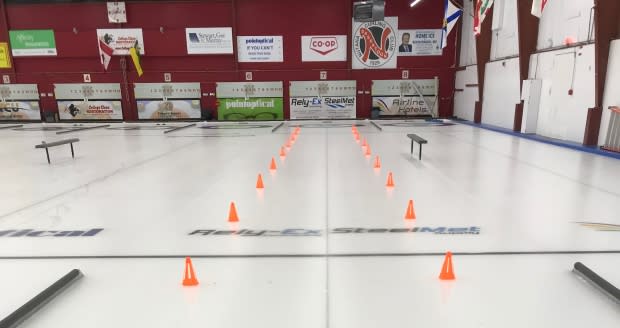Science of sweeping: Champion curler teams up with U of Sask. to find out how to do it right
A champion curler says you may be hurrying hard all wrong.
Eugene Hritzuk has been working with the University of Saskatchewan to study how curlers are using their push brooms. Hritzuk is a two-time Saskatchewan curling champion and six-time Canadian senior champion.
Going back several years, broom manufacturers were using a very textured and abrasive fibre, Hritzuk said.
"What it was actually doing was scratching the curling ice with tiny little scratches," Hritzuk told CBC Saskatchewan's Afternoon Edition.
The curling stone has a running surface that would then follow the scratches in the ice, he said.
"It was like joystick curling," he said. "You actually create little ruts and the rocks follow those and it goes in weird and wonderful ways."

The World Curling Federation didn't agree with this approach, Hritzuk said. After a 2015-16 curling season that saw players and observers debating new sweeping techniques and broom technology — a controversy that became known as "broomgate" — the federation decided one material would become universal, Hritzuk said.
The new material is not abrasive and doesn't cause scratches or ruts, but instead polishes the ice, so it involves a different kind of sweeping, Hritzuk said.
"A lot of curlers haven't adapted to that," he said.
Hritzuk said curlers have told him they were scratching the ice when he said they were not. This difference of opinion is what led Hritzuk to connect with the University of Saskatchewan College of Engineering, which has done similar research in the past.
"We decided, let's find out what the curling brushes are really doing to the ice," Hritzuk said.
Study done with a 'smart broom'
The study was done last weekend, and Hritzuk said it was a complicated process. He needed a heavy sweeper, a medium sweeper, and a light sweeper. The researchers recruited two junior competitive curlers — one male and one female — along with professionals Kirk Muyres and Colton Flasch.
Next they identified different ice segments and photographed each piece of ice individually before and after sweeping to analyze it. They now have 60 samples to go through and are running 120 photographs through image-analysis software.
The hope is to determine if there is anything different before or after sweeping and if so, what the difference is, Hritzuk said.
As well, the research used a special "smart broom."
"These smart booms have sensors in the pad that determine how much pressure you're putting. And also they tell you how many strokes per second," Hritzuk said. "So we tried to get all the curlers to sweep at their maximum."

The female junior curler was sweeping at about 50 pounds of pressure, the male junior curler was about 100 pounds, and the senior professionals were sweeping at around 120 pounds, Hritzuk said. They tried to get all the curlers to sweep at four strokes per second.
If his research proves that the new brooms do just polish the ice instead of scratching it, curling sweeping needs to change.
"You're going to literally sweep on the opposite side of the rock," Hritzuk said. "There is a significant difference in the two."
If sweepers are not scratching the ice, a curler needs to polish the opposite place of where they want the rock to go, he said, which causes the rock to grab the unpolished ice and move over that way.
Hritzuk said everyone has their opinion about sweeping and it is hard to argue without science, but the researchers expect to have a report after everything is analyzed in the next couple of months.

